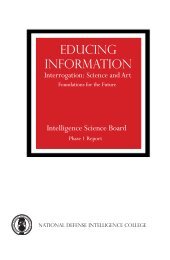Critical Thinking and Intelligence Analysis
Critical Thinking and Intelligence Analysis
Critical Thinking and Intelligence Analysis
Create successful ePaper yourself
Turn your PDF publications into a flip-book with our unique Google optimized e-Paper software.
TESTIMONIAL: APPLYING CRITICAL THINKING<br />
This is a true story. All the characters are real <strong>and</strong> really naive.<br />
As a fresh graduate of NSA’s critical thinking <strong>and</strong> structured analysis class,<br />
I attended an <strong>Intelligence</strong> Community class on counterintelligence. My fellow<br />
students included folks from all over the community, including CIA <strong>and</strong> FBI case<br />
officers. During the class, the instructor put forth a case study for students<br />
to think about <strong>and</strong> decide how best to “analyze <strong>and</strong> investigate” to find the<br />
mole. Differing opinions surfaced, but a common thread appeared among the<br />
case officers: follow your “gut” feeling <strong>and</strong> collect evidence to support that<br />
assumption, no matter how long it took.<br />
The instructor, enjoying the collective mindset <strong>and</strong> the opportunity to<br />
shatter paradigms, concentrated on how information was collected <strong>and</strong> analyzed.<br />
Again, the case officers agreed the best solution was to continue gathering<br />
information until you “proved your case.” I, the lone NSA token student, raised<br />
my objection, “How long is long enough Until you’ve ruined the career of<br />
innocent, hardworking persons in the IC, or until you find another answer you<br />
like” Although it did not earn me friends, it did open up a window to inform<br />
these case officers <strong>and</strong> other attendees about the intricacies of analysis.<br />
<strong>Critical</strong> thinking is not just about putting information together, finding<br />
a pattern, then choosing an answer, it is about reducing bias, considering all<br />
options available, <strong>and</strong> presenting options to a decision–maker. And critical<br />
thinking is about paying attention to what <strong>and</strong> how you are doing it. I reasoned<br />
that, since the investigators in the case study concentrated on only one<br />
Source: A mid–level intelligence professional at the National Security Agency<br />
from the evidence. At their most basic level, these inferences depend<br />
on credibility (can it be believed), relevance (does the evidence bear on<br />
the issue), <strong>and</strong> inferential or probative force (how compelling is it in<br />
answering the questions raised by the issue). Unfortunately, no mass<br />
or body of evidence – in intelligence or anywhere else – comes with<br />
these three properties already established. Establishment of these<br />
properties to abet uncertainty reduction through inference occurs<br />
only through a process of argument, creative hypothesis generation,<br />
<strong>and</strong> the development of chains of reasoning.<br />
Authenticity, accuracy, <strong>and</strong> reliability represent criteria for<br />
establishing the credibility of tangible evidence. 128<br />
An analyst striving<br />
128 “Tangible evidence” is a technical term describing things that bear<br />
relevance to an issue under scrutiny. It is contrasted with “testimonial evidence”<br />
– 52 –
















